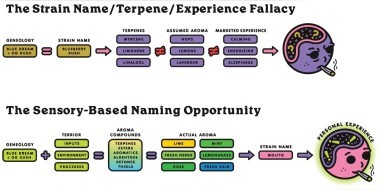New York, NY--The cannabis industry finds itself at a pivotal juncture, deciding whether to mold cannabis into an upscale commodity or keep it as an economical agricultural product. The ascension into a luxury market like wines or spirits demands a strategic, customer-centric branding approach.
[Image via Cannabis Industry Journal]
According to an article published in Cannabis Industry Journal, an initial step in this transformation requires overcoming the barrier of cultivar identification. The absence of regulated cultivar naming curbs innovation and hinders clarity in communicating strain properties, creating a disconnect in branding.
The article noted that precedents from the alcohol, coffee, and consumer-packaged goods (CPG) sectors provide substantial groundwork. Through robust sensory science and analytical product characterization, these industries have demonstrated how cannabis can redefine its market.
Per the article, evidence indicates that aroma is a significant determinant of consumer satisfaction. As legality and familiarity with cannabis increase, consumers gravitate towards brands offering a consistently superior experience. Brands that best relay this experience and then consistently deliver it will triumph. However, describing aroma via strain names or THC content fails to establish a coherent brand promise.
The article noted that the traditional approach to cannabis branding overlooks a great opportunity in cultivar characterization. Sensory science – a discipline used to evaluate and interpret human reactions to materials – could be utilized in the cannabis industry despite the challenges, as it's proven beneficial in various CPGs.
Innovation in motion
Innovative methods are already in motion. A recent study introduced a novel cannabis aroma wheel. Sensory scientists evaluated randomly sampled cannabis flower over months, developing a lexicon to characterize cannabis aroma. Trained panels can use this tool, which is freely available, marking the start of a data-driven cannabis lexicon development.
This lexicon aims to provide accurate product aroma descriptions, growing alongside the industry. Future lexicons could expand to tactile and appearance sensory attributes, fostering craftsmanship in the cannabis industry.
As per the article, dispensaries' role in implementing standardized quality metrics is crucial. By applying sensory science, brands can distinguish their products amidst various strain names and high-potency flowers, building consumer trust and product value.
The aroma characterization can redefine cannabis products, enhance the dispensary experience, facilitate sales, and open doors to unique cultivars. This robust, sensory-based branding will enhance the consumer experience and encourage good manufacturing practices, improving the quality and safety of cannabis products.
The article noted that adopting sensory science in cannabis heralds a shift towards connoisseurship, challenging brands to shake off "bad habits." The cannabis industry has significant potential as a luxury good.
Learn more in the entire Cannabis Industry Journal article.
